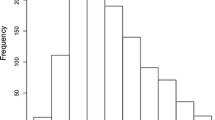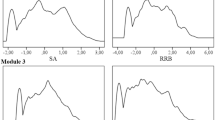Abstract
Cluster analysis was performed on factor analytic symptom profiles obtained from the Achenbach CBCL for a clinical sample of 204 3- to 5-year-old boys containing 79 autistic and autistic-like children. Patterns of results across 2-, 3-, 4-, 5-, and 6-cluster solutions are presented. Clustering identified an autistic group as soon as three clusters were formed. As more clusters were obtained, this autistic cluster was subdivided according to presence/absence of anxiety and level of functioning. Other clusters included an emotional/behavioral disorder group, with some differentiation into Externalizing and Internalizing clusters, and a group of relatively normal children with few symptoms.
Similar content being viewed by others
References
Achenbach, T. M. (1966). The classification of children's psychiatric symptoms: A factor analytic study.Psychological Monographs, 80 (7, Whole No. 615).
Achenbach, T. M. (1978). The Child Behavior Profile: I. Boys 6–11.Journal of Consulting and Clinical Psychology, 46, 478–488.
Achenbach, T. M., & Edelbrock, C. S. (1979). The Child Behavior Profile: II. Boys aged 12–16 and girls aged 6–11 and 12–16.Journal of Consulting and Clinical Psychology, 47, 223–233.
Achenbach, T. M., & Edelbrock, C. S. (1983).Manual for the Child Behavior Checklist. Burlington: Department of Psychiatry, University of Vermont.
Achenbach, T. M., & Edelbrock, C. S. (1984). Psychopathology of childhood.Annual Review of Psychology, 35, 227–256.
American Psychiatric Association. (1980).Diagnostic and statistical manual of mental disorders (3rd ed.). Washington, DC: Author.
American Psychiatric Association. (1987).Diagnostic and statistical manual of mental disorders (3rd ed. rev.). Washington, DC: Author.
Andreason, N. C., Grove, W. M., & Maurer, R. (1980). Cluster analysis and the classification of depression.British Journal of Psychiatry, 137, 256–265.
Cohen, D. J., Paul, R., & Volkmar, F. R. (1987). Issues in the classification of pervasive developmental disorders and associated conditions. In D. J. Cohen & A. M. Donnellan (Eds.),Handbook of autism and pervasive developmental disorders. New York: Wiley.
Curry, J. F., & Thompson, R. J., Jr. (1979). The utility of behavior checklist ratings in differentiating developmentally disabled from psychiatrically referred children.Journal of Pediatric Psychology, 4, 345–352.
Curry, J. F., & Thompson, R. J., Jr. (1982). Patterns of behavioral disturbance in developmentally disabled children: A replicated cluster analysis.Journal of Pediatric Psychology, 7, 61–73.
Dahl, E. K., Cohen, D. J., & Provence, S. (1986). Atypical development:DSM-III and the pervasive developmental disorders of early onset.Journal of American Academy of Child Psychiatry, 26, 170–180.
Edelbrock, C. (1979). Mixture model tests of hierarchical clustering algorithms: The problem of classifying everybody.Multivariate Behavioral Research, 14, 367–384.
Kolvin, I. (1971). Studies in the childhood psychoses. I. Diagnostic critera and classification.British Journal of Psychiatry, 118, 415–421.
Morris, R., Blashfield, R., & Satz, P. (1981). Neuropsychology and cluster analysis: Potentials and problems.Journal of Clinical Neuropsychology, 3, 79–99.
Prior, M., Boulton, D., Gazjago, C., & Perry, D. (1975). The classification of childhood psychoses by numerical taxonomy.Journal of Child Psychology and Psychiatry, 16, 321–330.
Rescorla, L. (1986). Preschool psychiatric disorders: Diagnostic classification and symptom patterns.Journal of the American Academy of Child Psychiatry, 26, 162–169.
Richman, N., Stevenson, J. E., & Graham, P. J. (1982).Preschool to school: A Behavioural study. London: Academic Press.
Sherman, M., Shapiro, T., & Glassman, M. (1983). Play and language in developmentally disordered preschoolers: a new approach to classification.Journal of American Academy of Child Psychiatry, 22, 511–524.
Siegel, B., Anders, T. F., Ciaranello, R. D., Bienenstock, B., & Kraemer, H. C. (1986). Empirically derived subclassification of the autistic syndrome.Journal of Autism and Developmental Disorders, 16, 275–293.
Sokol, R. R., & Sneath, P. H. (1963).Principles of numerical taxonomy. San Francisco: W. H. Freeman.
Volkmar, F. R., Cohen, D. J., & Paul, R. (1986). An evaluation ofDSM-III criteria for infantile autism.Journal of the American Academy of Child Psychiatry, 26, 190–197.
Wing, L., & Attwood, A. (1987). Syndromes of autism and atypical development. In D. J. Cohen & A. Donnellan (Eds.),Handbook of autism and pervasive developmental disorders. New York: Wiley.
Wolkind, S. N., & Everitt, B. (1974). A cluster analysis of the behavioural items in the preschool child.Psychological Medicine, 4, 422–427.
Author information
Authors and Affiliations
Rights and permissions
About this article
Cite this article
Rescorla, L. Cluster analytic identification of autistic preschoolers. J Autism Dev Disord 18, 475–492 (1988). https://doi.org/10.1007/BF02211868
Issue Date:
DOI: https://doi.org/10.1007/BF02211868




